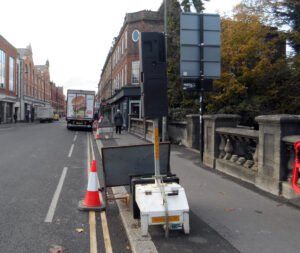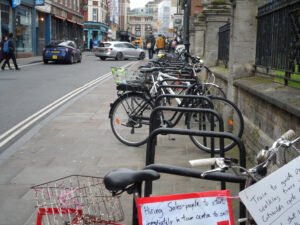A view from the pavement

By Sushila Dhall
Sushila is Chair, Oxford Pedestrians Association (OxPA)
Pedestrians are supposed to be at the top of the hierarchy in road-use planning, but is this always the case? Veteran campaigner Sushila Dhall shines a light on some of the issues faced by walkers and wheelchair users.
OxPA

Oxford Pedestrians Association (OxPA) was founded in 1995. Those on foot were feeling marginalised by encroachment onto pavement space in the city – by parked cars, cycles, bins, overhanging hedges, workers’ signs.
We work on behalf of all pedestrians, including wheelchair users and people with other mobility support needs. We call for:
- pavements that are wide (two wheelchair users should be able to pass with comfort and dignity, and people should be able to walk side by side), level, continuous and unobstructed
- crossings that are responsive, level and give enough time to cross
- peaceful streets with clean air
Current issues

Since OxPA started, we feel that conditions in the city have worsened. The exception is Frideswide Square – a bold and beautiful step in the right direction. On the whole:
- cycle lanes and car parking have enroached on pavements, painted with white lines
- motor traffic has increased (due in part to the Westgate centre pulling drivers into the city centre)
- scooter parks have been created on pavements
- there are huge unaddressed puddles (’ponding’) at pedestrian crossings
- workers’ signs block pavements
- poles and bus shelters reduce already narrow routes
- following Covid, there are street cafés on pavements (we welcome these but ask that space in the road be allocated to pedestrians to make up for the lost pavement)
What have we done?
OxPA has carried out audits of pavements throughout the city, none of which are universally fit for purpose. A pavement is only as good as its narrowest, most obstructed part.
We carried out a survey of members on the recent proposal to regularise cycling on Cornmarket and Queen Street during working hours. (Overall OxPA members are against this.) A significant number of responders said they never come into the city centre as it is inaccessible to them. Our audits have also shown that the two worst walking areas of Oxford are the routes between the rail station and the city centre, and those in Headington shopping area.
Human bollards
Perhaps our most famous success was the human bollards campaign 2 years ago. For a period of months we regularly put ourselves in place of non-working bollards on Oriel Square, Turl Street and Broad Street.
Ironically it was the behaviour of some drivers that got us so much publicity – they screamed at, abused, threatened and even drove into us. Captured on camera, this brought in the BBC in, and led to the reinstatement of the bollards. We thank Thames Valley Police for their support during these frightening moments.
Drivers called the police demanding that we be moved, but the police pointed to the road signs and made the drivers turn back.
The success of this campaign was encouraging to people who walk, and gained us new members. The method was later used by campaigners in protecting safe routes to school.
What next?
We have often been asked if we can become an association for the whole of Oxfordshire, but for this to be possible we would need representatives in county towns and villages.
We are now busy finalising places for 14 benches on urban walking routes in the city, thanks to a generous donation to OxPA from the family of late member Keith Holly. Each bench will be engraved with a relevant poetic quote chosen by OxPA members.
It is an important part of OxPA’s work that we give positively to the city as well as demonstrating what is not working and needs improvement.
Image credits
OxPA
